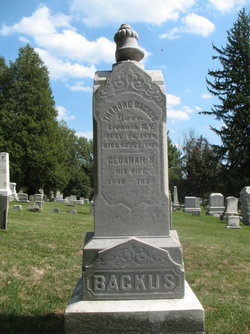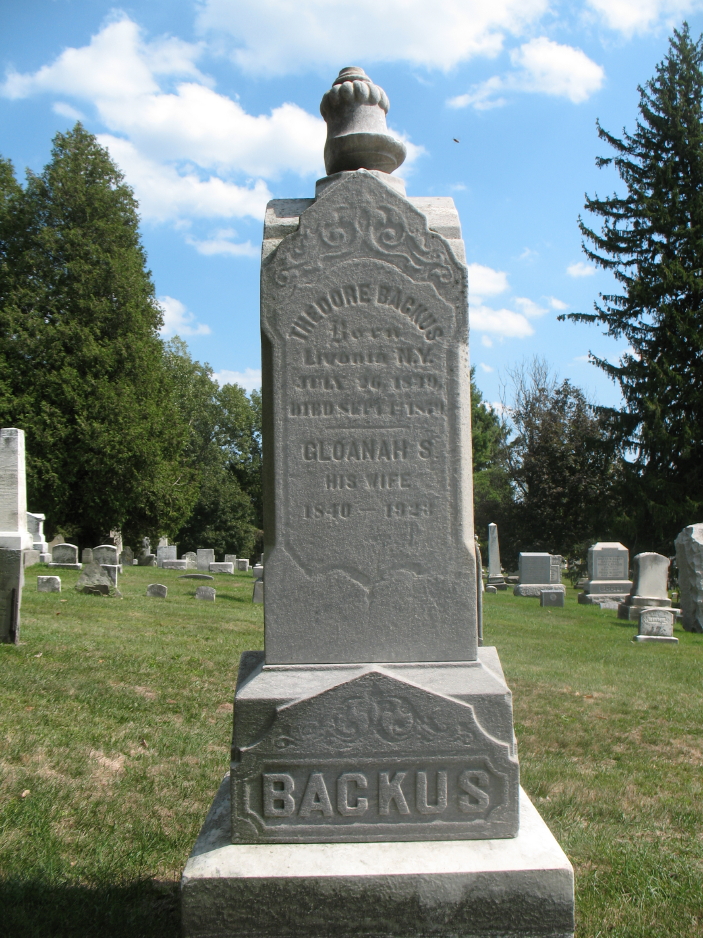Lima Recorder
Lima, Livingston County, New York.
November 24, 1988
THE GANOUNG HOUSE
Located on Poplar Hill Road overlooking the Bristol Hills to the south, the setting of this Lima cobblestone has changed little during its history. As with the Markham House featured last time in "In the Lima Light," the exact date of construction of the Ganoung House is also unknown. The five bay facade, the semi-circular louver in he north gable, and the splayed, flat arch limestone lintels of the window and door openings are characteristic of vernacular Federal style architecture, popular in the U.S. until the 1820s. In Lima, however, Federal design elements are known to have been employed in residential construction into the 1830s when the cobblestone building technology was also being introduced. Thus, it is thought this house may have been built some time during the 1830s, possibly by Elisha Winans, who purchased the property in 1837 from Sheldon Ashley.
The house is named for the Ganoung family whose various members owned the property from 1853 to 1937. Jacob Ganoung first acquired the property in 1853 from the Horace Doolittle estate and then sold it two months prior to his death in 1866 to his nephew Hiram H. Ganoung. Census records indicate that Jacob may have used the house in conjunction with another farm he owned on Woodruff Road, approximately .5 mile to the east of the property. The 1855 census states, for example, that Jacob's single brother Hiram and an Irish male servant occupied the stone house while Jacob was living in another of wood construciton. Similarly, even though Hiram H. Ganoung was the legal owner of the property after 1866, in the 1875 census, Jacob's daughter Gloanah and husband Theodore Backus are listed as occupying the stone dwelling. Hiram H. is believed to have died in 1889 so that when his aunt Angeline, Jacob's wife, died in 1893, she was the owner of all the Ganoung lands. These she gave by will to her daughters, Emma Jane Franklin and Gloanah Backus, her grandson George H. Backus, and her granddaughters, Nettie J. Franklin Ollerenshaw and Tennie B. Backus (later Coykendall). Nettie Ollerenshaw acquired the rights of the other heirs and continued to own the Ganoung House property until she and then her husband died and the estate was sold in 1937 to James Hanna of York. The home has always played a role in the history of Lima agriculture. Agricultural censuses indicate that from 1855 to 1875, the farm was listed as shearing about 300 sheep, making it one of the larger Lima sheep raising operations at the time.
Deeds prior to the 1870s record the property as consisting of 103 acres plus swamp land. This swamp land was part of the more than 700 acres of such land that was drained, beginning in the 1870s, in the nearby hamlet of South Lima to produce muck land for the growing of onions. Later deeds for this property describe some of its acreage as consisting of muck rather than swamp land.
In 1902 the county atlas described the Backus landholdings, of which the house was a part, as consisting of "three hundred and thirty acres of which thirty are muck. The chief resources are general farm products such as beans, cabbage, cereals, etc., with dairying as a feature."
Lima Recorder
Lima, Livingston County, New York.
November 24, 1988
THE GANOUNG HOUSE
Located on Poplar Hill Road overlooking the Bristol Hills to the south, the setting of this Lima cobblestone has changed little during its history. As with the Markham House featured last time in "In the Lima Light," the exact date of construction of the Ganoung House is also unknown. The five bay facade, the semi-circular louver in he north gable, and the splayed, flat arch limestone lintels of the window and door openings are characteristic of vernacular Federal style architecture, popular in the U.S. until the 1820s. In Lima, however, Federal design elements are known to have been employed in residential construction into the 1830s when the cobblestone building technology was also being introduced. Thus, it is thought this house may have been built some time during the 1830s, possibly by Elisha Winans, who purchased the property in 1837 from Sheldon Ashley.
The house is named for the Ganoung family whose various members owned the property from 1853 to 1937. Jacob Ganoung first acquired the property in 1853 from the Horace Doolittle estate and then sold it two months prior to his death in 1866 to his nephew Hiram H. Ganoung. Census records indicate that Jacob may have used the house in conjunction with another farm he owned on Woodruff Road, approximately .5 mile to the east of the property. The 1855 census states, for example, that Jacob's single brother Hiram and an Irish male servant occupied the stone house while Jacob was living in another of wood construciton. Similarly, even though Hiram H. Ganoung was the legal owner of the property after 1866, in the 1875 census, Jacob's daughter Gloanah and husband Theodore Backus are listed as occupying the stone dwelling. Hiram H. is believed to have died in 1889 so that when his aunt Angeline, Jacob's wife, died in 1893, she was the owner of all the Ganoung lands. These she gave by will to her daughters, Emma Jane Franklin and Gloanah Backus, her grandson George H. Backus, and her granddaughters, Nettie J. Franklin Ollerenshaw and Tennie B. Backus (later Coykendall). Nettie Ollerenshaw acquired the rights of the other heirs and continued to own the Ganoung House property until she and then her husband died and the estate was sold in 1937 to James Hanna of York. The home has always played a role in the history of Lima agriculture. Agricultural censuses indicate that from 1855 to 1875, the farm was listed as shearing about 300 sheep, making it one of the larger Lima sheep raising operations at the time.
Deeds prior to the 1870s record the property as consisting of 103 acres plus swamp land. This swamp land was part of the more than 700 acres of such land that was drained, beginning in the 1870s, in the nearby hamlet of South Lima to produce muck land for the growing of onions. Later deeds for this property describe some of its acreage as consisting of muck rather than swamp land.
In 1902 the county atlas described the Backus landholdings, of which the house was a part, as consisting of "three hundred and thirty acres of which thirty are muck. The chief resources are general farm products such as beans, cabbage, cereals, etc., with dairying as a feature."
Family Members
Sponsored by Ancestry
Advertisement
Records on Ancestry
Advertisement













